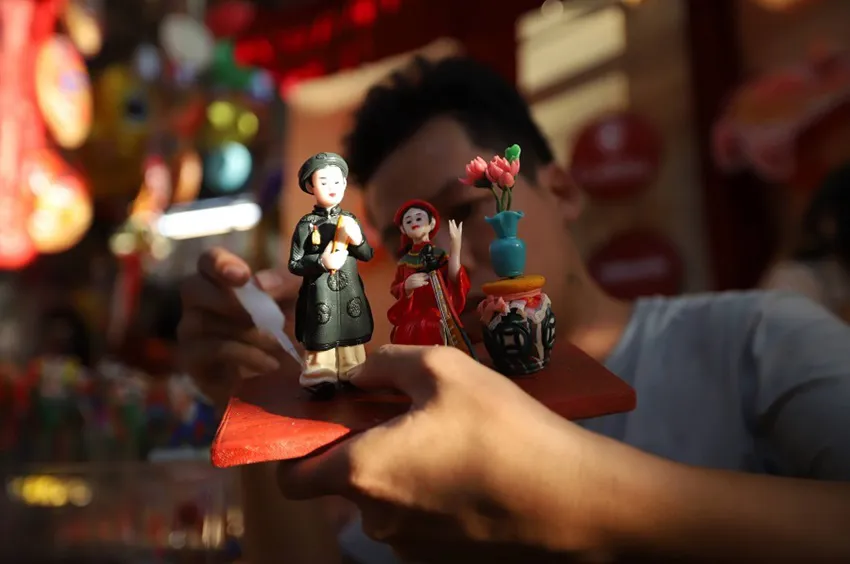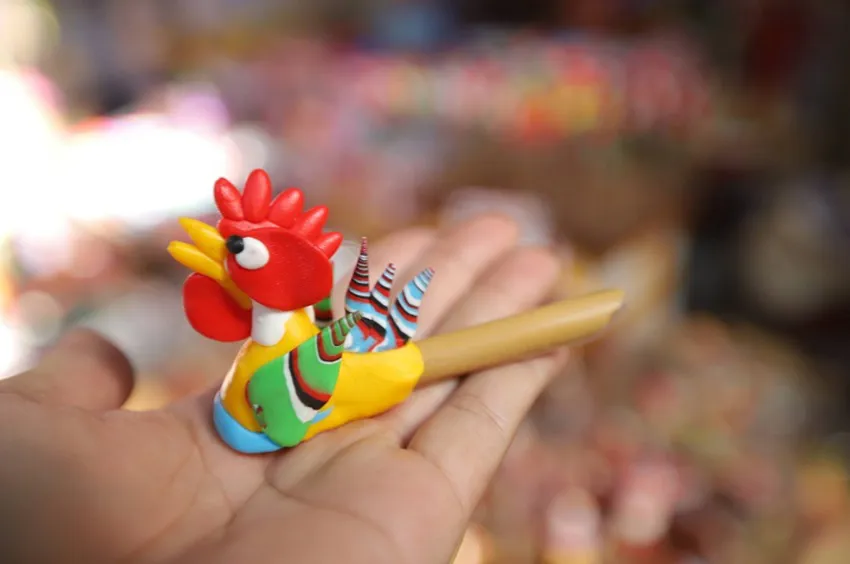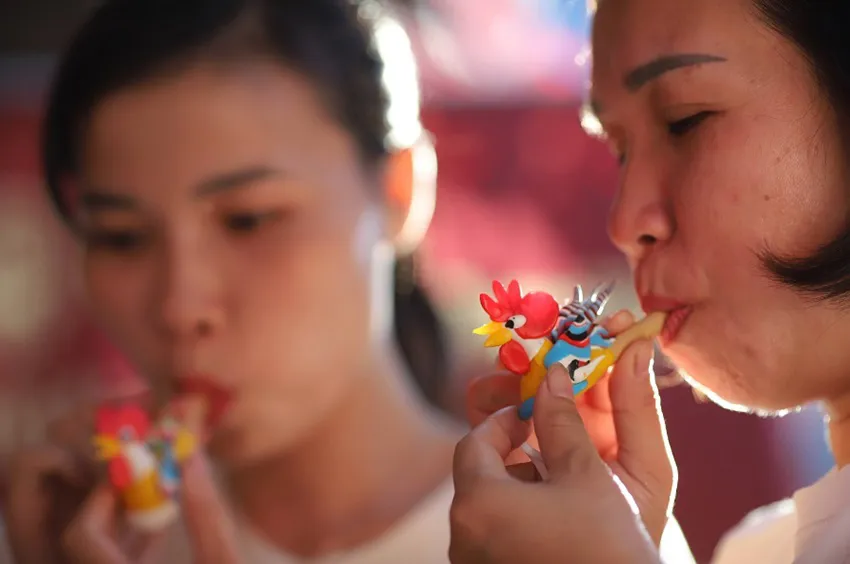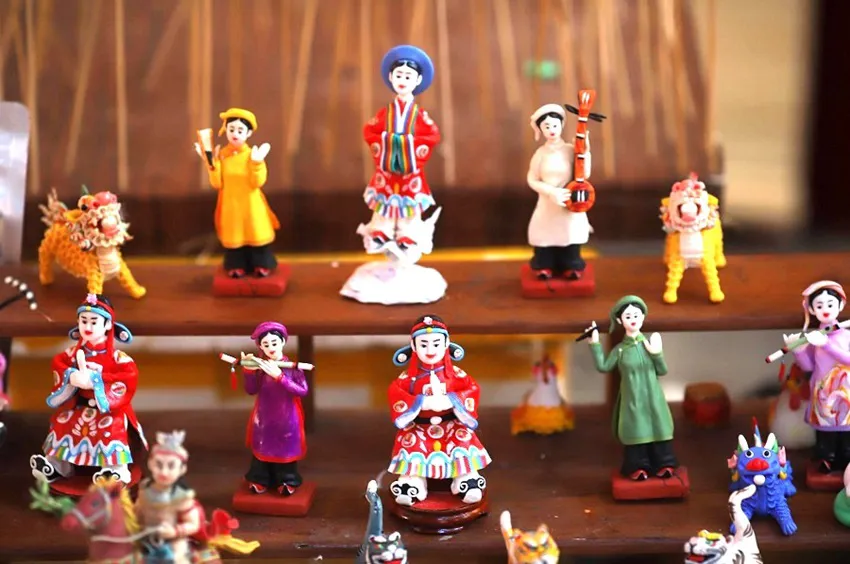The man who spreads the art of to he beyond village
With devotion to preserving the traditional craft of his homeland, artisan Dang Van Hau is popularizing traditional toys known as to he beyond village boundaries.
Rice powder animal toys or to he figurines - the traditional toys for children have been revived and available in the market thanks to the efforts of artisan Dang Van Hau, 37, from Xuan La Village, Phu Xuyen District, Hanoi.
Creativity and variations
| The to he work entitled 'Mid-Autumn Lantern Parade' by artisan Dang Van Hau. Photo: Huy Pham/The Hanoi Times |
Artisan Dang Van Hau recently won a special prize at the first Hanoi City Craft Village Product Contest held by the municipal People's Committee.
In just a few minutes, his skillful hands transform colorful lumps of dough into unique works of art: storks, truncated cones, the 12 Chinese zodiac animals, five fruit bowls, peacocks, phoenixes, the quarrel of the six beasts, a pair of ancient shoes, money toads, the four holy beasts, and others.
Dang Van Hau was born in 1985 and grew up in Xuan La Village, home to a unique craft of making to he, or edible toy figurines made of rice powder. From a young age, he was enthusiastically taught the history and practical techniques of to he by his maternal grandfather, the renowned artisan Dang Van Ha. Gradually, his love for this art grew, and he later decided to make to he his profession, dedicating his heart and soul to preserving and developing the traditional craft.
| Artisan Dang Van Hau with his work entitled Mid-Autumn Lantern Parade, which won a Special Prize at the Hanoi Craft Village Product Contest 2023. Photo: Le Nam/The Hanoi Times |
With his relentless creativity, the artisan has created a myriad of wondrous to he works that are imbued with folklore and display amazing techniques and aesthetics. With the help of cultural scholars and elderly artisans in the village, Hau has restored ancient figurine models that were once slipped into oblivion.
"In particular, there are antique collectors who want me to recreate some objects, and I satisfy their demand. I'm making figurines depicting royal court costumes from the Nguyen Dynasty, which requires meticulousness, a lot of time kneading, and time to shape each pattern accurately," he said.
In addition to traditional products, from time to time, craftsman Dang Van Hau also varies the shape to introduce modern to he models that appeal to customers. For the Mid-Autumn Festival, Hau designed a set with Hang Nga and Chu Cuoi (Moon Goddess and Moon Boy) wearing Vietnamese costumes but with chibi faces (chibi is a Japanese art style in which exaggerated characters typically have oversized heads, big eyes, and small torsos and limbs).
| Unique to he figurines depict royal Vietnamese women made by artisan Dang Van Hau. Photo: Huy Pham/The Hanoi Times |
At Christmas, he offers Santa Clauses standing next to the Snow Queen, Elsa (a character in the animated movie Frozen that's very popular with little girls). It is this creativity that attracts children and increases the competitiveness of traditional toys.
Hau was awarded the title of Hanoi Craftsman by the Chairman of the Hanoi People's Committee at the age of 29, making him the youngest craftsman in Xuan La Village.
Helping to he ‘live’ longer
About spreading to he beyond the village's boundaries, Hau admitted that it took a lot of effort, from finding and replacing production materials to designing models and promoting the final works.
In terms of materials, the artist said the Xuan La people used to use finely ground, rice flour mixed with natural dyes, such as turmeric or Japanese pagoda tree flowers for yellow, gardenia flowers for red, gardenia, burnt straw or false daisies, indigo leaves or lesser galangal leaves for blue.
| A Vietnamese traditional toy is remodeled by an artisan. Photo: Huy Pham/The Hanoi Times |
Around 1960, the villagers switched to glutinous rice, which is more flexible and easier to shape than ordinary rice. As a result, their toys were sold in many places and spread to provinces and cities throughout the country.
However, to he, which is traditionally made from rice powder, only lasts for 1-2 days before it dries out, becomes moldy, and crumbles. That's why, since 2014, Hau has been experimenting with additives mixed into the dough to make to he "live" longer and thus go further. It is also because of his sophisticated molding techniques that some of his products cost up to hundreds of thousands of Vietnamese dong, with some sets worth millions of dong.
Currently, craftsman Dang Van Hau often brings his products to tourist areas and handicraft fairs. He has also been invited to participate in various talk shows or to demonstrate the creation process at cultural events at the central and city levels. Hau serves both the needs of children with items priced at tens of thousands of Vietnamese dong, and the high-end market of handicraft gifts.
He regularly exhibits and promotes his products at events, tourist areas, fairs, festivals, and other locations in Hanoi's Old Quarter. His own stall at 75 Hang Ma Street has also attracted a large number of visitors and customers who love traditional values.
Thus, through the talented hands of the young artist, to he, the rustic children's toy, has enhanced its value in today's modern life.
| The toys created by Hau are not only for children but also for adults. Photo: Huy Pham/The Hanoi Times |
| Hau's wonderful to he creations. Photo: Huy Pham/The Hanoi Times |
| Artisan Dang Van Hau regularly showcases his talent as well as exhibits to he products at cultural events and craft fairs in Hanoi. Photo courtesy of the artisan |


















